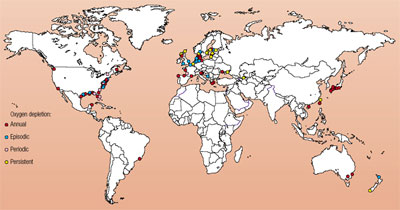Lack of oxygen triggers sex imbalance in fish
mongabay.com
March 29, 2006
SUMMARY: Oceanic oxygen depletion resulting from agricultural run-off and pollution can trigger sex imbalance in fish and pose an extinction risk according to a new study published by researchers in Hong Kong. The finding raises new concerns about “dead zones”—expanses of water so devoid of oxygen that most sea life cannot survive.
Ocean ‘dead zones’ trigger sex changes in fish, posing extinction threat
American Chemical Society release
Oxygen depletion in the world’s oceans, primarily caused by agricultural run-off and pollution, could spark the development of far more male fish than female, thereby threatening some species with extinction, according to a study published today on the Web site of the American Chemical Society journal, Environmental Science & Technology. The study is scheduled to appear in the May 1 print issue of the journal.
The finding, by Rudolf Wu, Ph.D., and colleagues at the City University of Hong Kong, raises new concerns about vast areas of the world’s oceans, known as “dead zones,” that lack sufficient oxygen to sustain most sea life. Fish and other creatures trapped in these zones often die. Those that escape may be more vulnerable to predators and other stresses. This new study, Wu says, suggests these zones potentially pose a third threat to these species — an inability of their offspring to find mates and reproduce.
The researchers found that low levels of dissolved oxygen, also known as hypoxia, can induce sex changes in embryonic fish, leading to an overabundance of males. As these predominately male fish mature, it is unlikely they will be able to reproduce in sufficient numbers to maintain sustainable populations, Wu says. Low oxygen levels also might reduce the quantity and quality of the eggs produced by female fish, diminishing their fertility, he adds.
In their experiments, Wu and his colleagues found low levels of dissolved oxygen — less than 2 parts per million — down-regulated the activity of certain genes that control the production of sex hormones and sexual differentiation in embryonic zebra fish. As a result, 75 percent of the fish developed male characteristics. In contrast, 61 percent of the zebra fish spawn raised under normal oxygen conditions — more than 5 parts per million — developed into males. The normal sex ratio of zebra fish is about 60 percent male and 40 percent female, Wu says.
“Reproductive success is the single most important factor in the sustainability of species,” Dr. Wu says. “In many places, the areas affected by hypoxia are usually larger than the spawning and nursery grounds of fish. Even though some tolerant species can survive in hypoxic zones, they may not be able to migrate out of the zone and their reproduction will be impaired.”
Hypoxia is considered one of the most serious threats to marine life and genetic diversity, Wu says. It occurs when excessive amounts of plant nutrients, particularly nitrogen, accumulate in oceans, freshwater lakes and other waterways. These nutrients trigger the growth of huge algae and phytoplankton blooms. As these blooms die, they sink to the ocean floor where they are decomposed by bacteria and other microorganisms. Decomposition depletes most of the oxygen in the surrounding water, making it difficult for marine life to survive.
Although some hypoxic areas — dead zones — develop naturally, scientific evidence suggests in many coastal areas and inland waters, hypoxia is primarily caused by agricultural run-off (particularly fertilizers) and discharge of domestic and industrial wastewaters.
 Map of dead zones from UNEP Geo Year Book 2003 |
Dead zones are developing along the coasts of the major continents, and they are spreading over larger areas of the sea floor, Wu says. The United Nations Environmental Programme estimates nearly 150 permanent and recurring dead zones exist worldwide, including 43 in U.S. coastal waters.
In the Gulf of Mexico, for instance, a dead zone the size of New Jersey, some 7,000 square miles, develops each summer. Other affected areas of the United States include coastal Florida and California, the Chesapeake Bay and Long Island Sound.